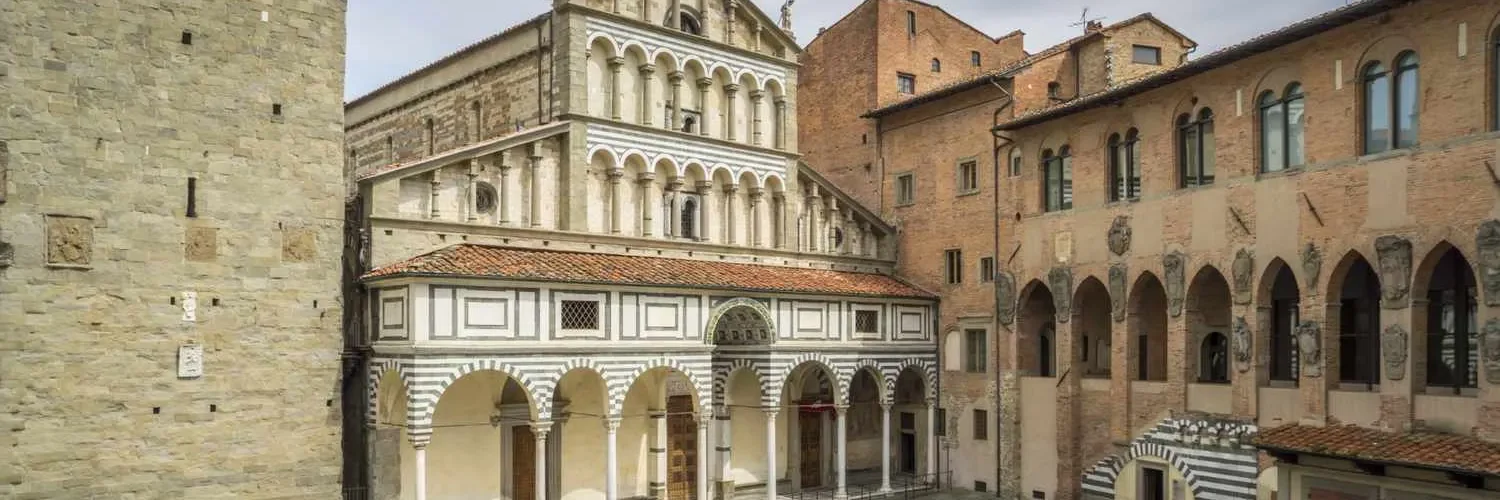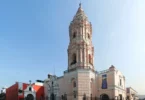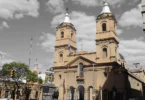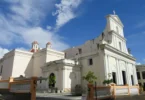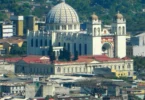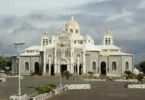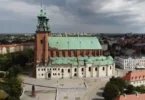Introduction
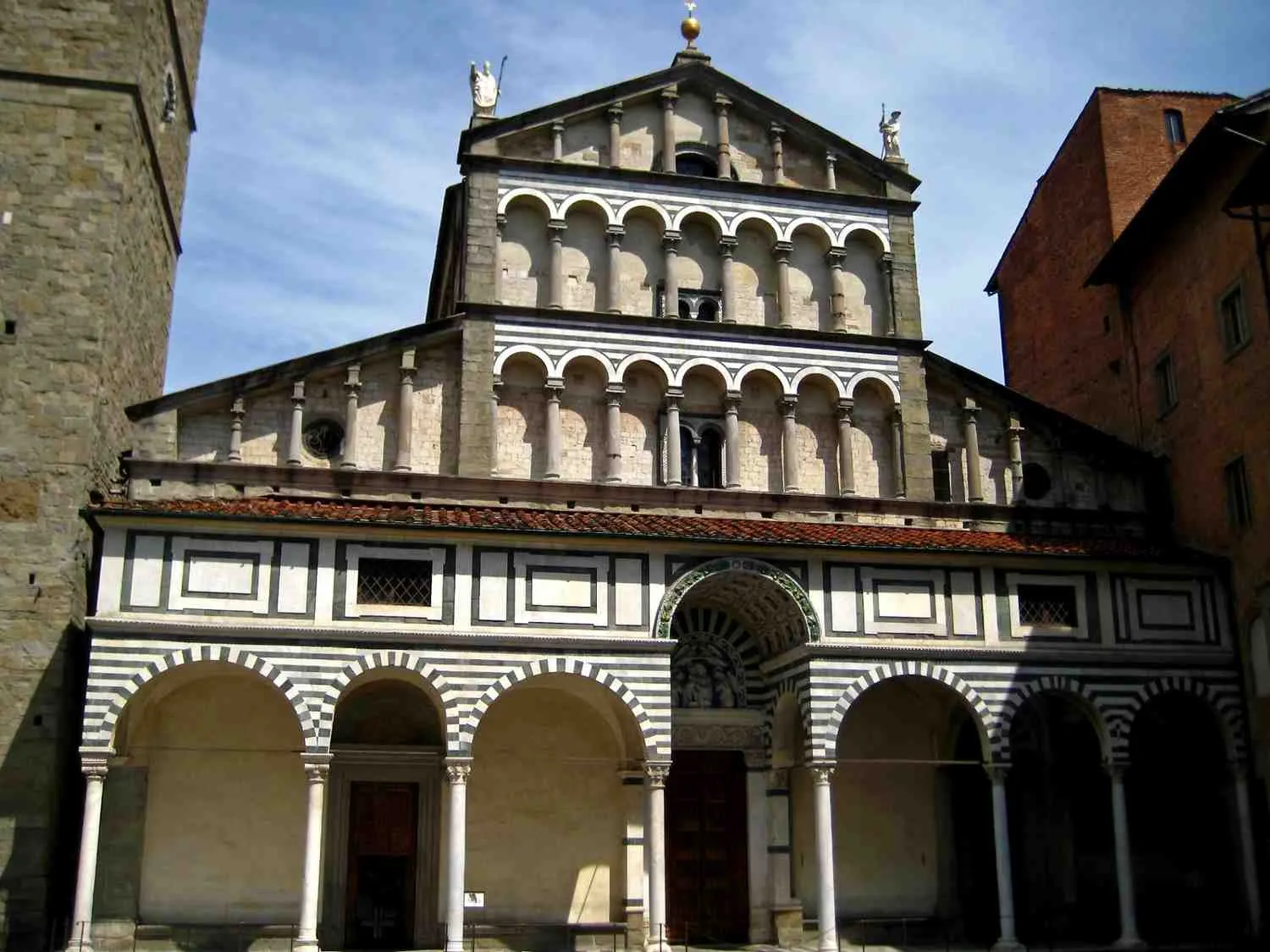
The Pistoia Cathedral, also known as the Cathedral of San Zeno (Italian: Duomo di Pistoia or Cattedrale di San Zeno), is the principal religious edifice in Pistoia, Tuscany, located in the heart of the city at the Piazza del Duomo. As the episcopal seat of the Diocese of Pistoia, it serves as the central place of Catholic worship in the region. The cathedral is dedicated to Saint Zeno of Verona, though its history reveals that it was originally dedicated to Saint Martin. This dedication changed during the Lombard domination, when it was reassigned to San Zeno. The cathedral, which likely dates back to the 10th century, is an outstanding example of Romanesque architecture, with its façade modeled after other significant churches in Pistoia, such as San Bartolomeo and Sant’Andrea. On either side of the pointed cusp of the façade stand two striking marble statues of the cathedral’s patron saints, San Zeno and San Jacopo, which were originally placed in the loggia.
The structure of the cathedral includes a bell tower and baptistery, with the interior featuring a traditional three-nave layout, a raised presbytery, and an underground crypt. Over the centuries, the cathedral has undergone numerous modifications, though it was painstakingly restored between 1952 and 1999, during which the original architectural lines were carefully restored. In recognition of its historical and religious significance, the cathedral was granted the status of a minor basilica by Pope Paul VI in December 1965. Today, the Pistoia Cathedral stands as a central symbol of the city’s rich history and its devotion to Saint Zeno, drawing visitors and pilgrims alike to admire its architectural beauty and sacred heritage.
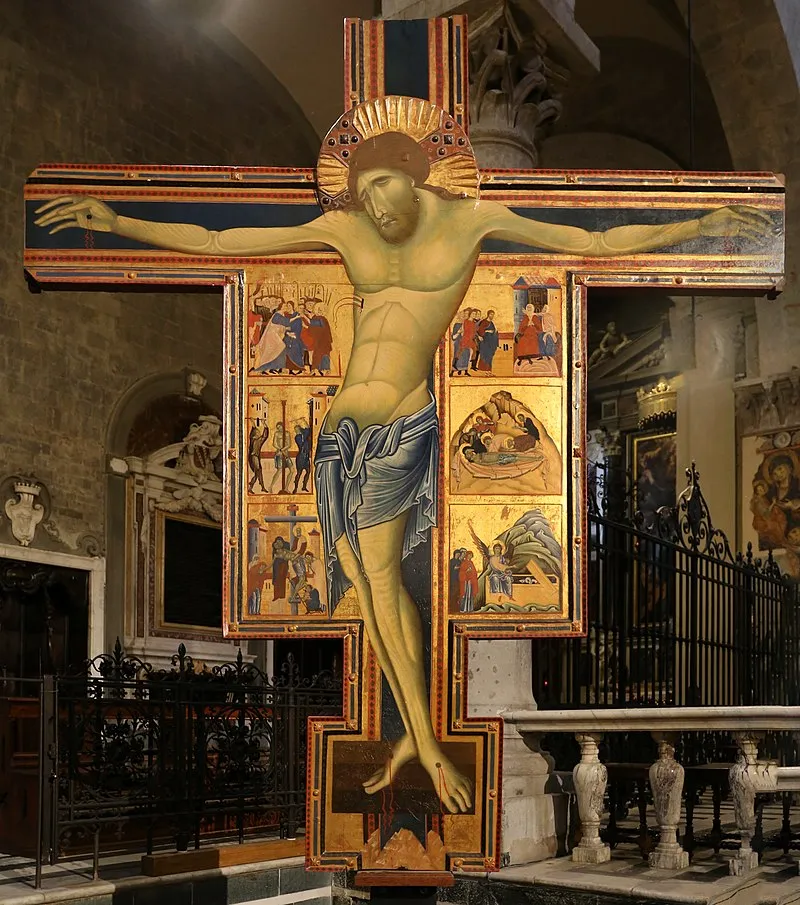
The history of the Pistoia Cathedral, or Cathedral of San Zeno, stretches over a millennium, with the earliest records suggesting the existence of a smaller cathedral in the city as early as the 5th century. Although the exact location of this early church is uncertain, it is speculated to have been situated either at the site of the present cathedral, where the Pieve di Sant’Andrea now stands, or at the location of the monastic complex of San Pier Maggiore. This was in keeping with the custom of building cathedrals near cemeteries, known as memoretum.
Early Mentions and Development
The first historical reference to the cathedral dates back to 923, when a notarial document from Count Cunerad of Teudicio mentioned an “Ecclesia SS. Zenonis, Rufinis et Felicis.” In 998, a diploma from Emperor Otto III described an early Christian structure located between the “regia” road (now known as Piazza del Duomo, Via Stracceria, and Via degli Orafi) and the city’s watchtower. This building, most likely an early version of the cathedral, marks the beginning of the cathedral’s long history. However, the cathedral faced significant challenges in the centuries to come. In 1108, it was severely damaged by a fire, and the restoration process likely took place during the first decades of the 12th century. By 1145, the cathedral had been sufficiently restored, as evidenced by the consecration of the altar dedicated to Saint James the Great by Bishop Atto.
Fires, Earthquakes, and Continuous Construction
The cathedral’s struggles with fire continued in 1202, when another fire caused extensive damage. In the aftermath of this destruction, between 1274 and 1275, the side aisles were covered with vaults, replacing the earlier wooden truss roofs. This period of construction and reconstruction was marked by the cathedral’s gradual transformation, leading to significant developments in its architecture. In 1298, an earthquake caused additional damage to the cathedral, prompting further repairs.
By 1336, a notable addition was made to the cathedral: a statue of Saint Zeno, sculpted by Jacopo di Mazzeo, was placed on the façade, symbolizing the growing importance of the cathedral’s patron saint.
Reconstruction and Renaissance Additions
Between 1379 and 1440, a major overhaul of the cathedral’s façade was undertaken. This involved the addition of three tiers of loggias and a portico, giving the cathedral a more refined and elegant appearance. In 1504, Andrea della Robbia was commissioned to embellish the archivolt, creating a vegetal festoon with the coat of arms of the Opera di San Jacopo in the center. He also designed the blue coffered ceiling with golden rosettes that adorned the central vault of the portico. Additionally, a bas-relief lunette depicting the Madonna with Child and Angels was added above the central door. Della Robbia completed these works in 1505, further enhancing the cathedral’s beauty.
Baroque and Neoclassical Modifications
The 16th and 17th centuries saw the cathedral undergo more significant changes. Between 1598 and 1614, the medieval presbytery was demolished. The chapels at the head of the side naves were altered, and the original apse was replaced by a Baroque tribune, which was surmounted by a dome designed by Jacopo Lafri. During this period, the central nave was covered with new cross vaults, and the ceiling of the tribune was decorated with paintings. Additional paintings were created for the walls of the tribune and the main chapel, further contributing to the Baroque transformation of the cathedral. In 1721, a statue of Saint James the Great, created by Andrea Vaccà, was added to the façade, continuing the tradition of commissioning works to honor the saints and patrons of the church. However, in 1786, the chapel dedicated to Saint James was demolished, as part of the ongoing alterations to the cathedral’s structure.
19th Century Modifications
The cathedral continued to evolve in the 19th century. Between 1834 and 1837, the presbytery underwent a neoclassical transformation by Giovanni Gambini, in line with the architectural tastes of the time. These changes involved the replacement of earlier features with neoclassical elements, including modifications to the altar and other decorative details.
Restoration in the 20th Century
The most significant restoration of the cathedral occurred between 1952 and 1966, when the Superintendency of Monuments undertook a comprehensive project to return the cathedral to its original appearance. This restoration included the removal of the five large cross vaults from the central nave, which had been added in 1657 and obscured the cathedral’s original polychrome wooden roof from 1338. Additionally, 19th-century plasterwork, added by Gambini in the 1830s, was removed, revealing the medieval architectural features hidden beneath. It is believed that during this process, a valuable cycle of frescoes was destroyed, with only faint traces remaining.
The medieval windows, which had been replaced by 17th-century ones, were also restored during this period, returning the cathedral to a more authentic medieval look. In the late 1990s, between 1997 and 2000, the bell tower underwent a restoration, ensuring the longevity and preservation of one of the cathedral’s most iconic features. Through centuries of construction, destruction, and restoration, the Pistoia Cathedral has evolved into a stunning testament to the city’s rich history and religious devotion.
Architecture of Cathedral of San Zeno, Pistoia, Italy
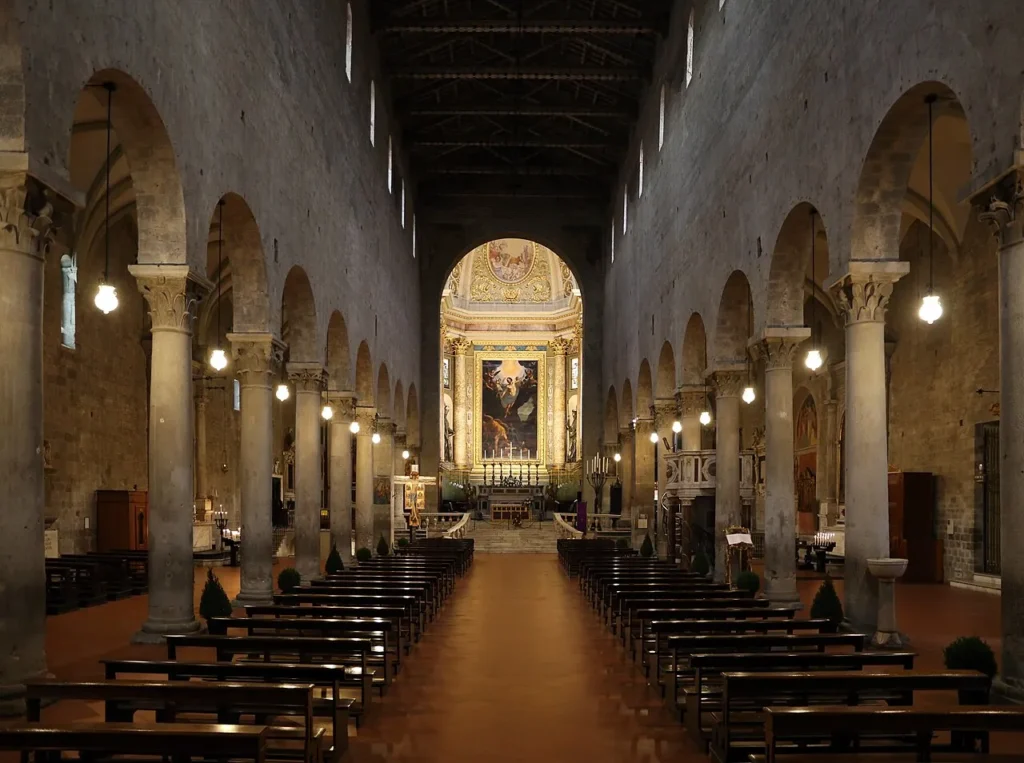
Architectural Style : Baroque architecture, Romanesque architecture.
Interior of the Cathedral
The interior of the cathedral is characterized by its architectural grandeur and historical significance. The presbytery is raised above the crypt, creating a dramatic distinction in levels. The church features three naves divided by rows of longitudinal columns. The central nave is crowned with a wooden truss roof, while the lateral naves are vaulted. Over the centuries, the cathedral has been home to numerous chapels and sacred relics, each contributing to its rich history.
Chapel of the Blessed Sacrament (Chapel of San Donato)
The Chapel of the Blessed Sacrament, also known as the Chapel of San Donato, houses the tabernacle and is a notable part of the cathedral. This chapel was founded by Bishop Donato de’ Medici around 1440, who funded its construction to house the miraculous image of the Madonna known as “delle Porrine.” The image was originally placed outside before being brought inside for safekeeping. The chapel is named after Bishop Donato de’ Medici, and his tomb, attributed to the renowned sculptor Antonio Rossellino, is located at the entrance. A significant painting by Lorenzo di Credi, Madonna Enthroned between Saints John the Baptist and Donato, adorns the right wall of the chapel. This work was originally commissioned to Andrea del Verrocchio, and completed by his pupil, Lorenzo di Credi, after Verrocchio’s death. The figure of Saint Zeno, who stands next to the Madonna, is believed to be a tribute to the patron saint of the city.
In 1591, the chapel was incorporated into the cathedral under the patronage of the Pappagalli family, who took over its sponsorship. Between 1594 and 1596, the chapel was renovated based on the designs of Jacopo Lafri. The altar was raised towards the nave, and the chapel was further adorned with the Assumption of the Virgin, painted by Giovanni Battista Paggi. Under the altar is a marble statue of Saint Felice, a Pistoian priest, sculpted by Raffaello Petrucci.
Chapel of Sant'Atto
The Chapel of Sant’Atto is dedicated to Saint Atto, the first bishop of Pistoia. The chapel contains his urn, created in 1952 by Cleto Lapi, and placed on a silver step made by Silvestro Mariotti in 1855. Above the urn, a painting of Saints Baronto and Desiderio by Mattia Preti hangs, which originally came from the destroyed Foresi Benesperi altar. The chapel, often referred to as the “City Chapel,” was funded by donations collected from the citizens following the 1630 plague. The artwork originally commissioned for the chapel was a canvas portraying the Virgin and the patron saints of Pistoia interceding on behalf of the city. This piece was painted by Giacinto Gimignani in Rome but was removed in 1787 and relocated to the Church of San Francesco.
The current altar, a work by Andrea Vaccà, was sourced from the monastic church of Santa Maria degli Angeli. The chapel is also home to large frescoes, including Moses Receiving the Tablets of the Law by Luigi Sabatelli (1845) and The Deposition of Christ by Giuseppe Bezzuoli (1848). The dome is decorated with frescoes by Ulivelli and Vannucci.
Chapel of the Crucifix
The Chapel of the Crucifix houses the famous Silver Altar of San Jacopo, a masterpiece of medieval Italian goldsmithing. Originally placed in the Chapel of San Jacopo in the right nave, the altar was moved several times. It was relocated to the Chapel of San Rocco after the demolition of the San Jacopo chapel in 1785, and finally, it found its home in the Chapel of the Crucifix in 1953.
The altar was constructed by various skilled artisans between 1287 and 1450. Notable contributors include the workshop of Lunardo di Mazzeo and Piero di Giovanni da Pistoia, and the young Filippo Brunelleschi, who is believed to have worked on one side of the altarpiece. Brunelleschi is credited with sculpting two saints, Saint Augustine and an Evangelist, along with half-length portraits of prophets, Jeremiah and Isaiah. Other artists, including Filippo Lippi and Nofri di Buto, also contributed to the intricate silverwork that adorns the altar.
Chapel of the Last Judgement
The Chapel of the Last Judgement features fragments of a fresco depicting the Last Judgement by Giovanni da Ponte, painted between 1420 and 1425. In addition, there are fragments of a fresco illustrating scenes from Dante’s Divine Comedy. These frescoes, though fragmented, offer a glimpse into the artistic and theological vision of the time.
The Crypt
Beneath the presbytery lies the crypt, which dates back to the Romanesque period. Originally, it was defined by a series of columns and had three apses. The crypt underwent significant changes when the late Mannerist tribune was constructed above it, which led to the destruction of the central space. The lateral apses were buried and used as burial grounds. Designed by Jacopo Lafri, the current crypt has six stone columns supporting a ribbed vault ceiling. The altar is located in a small apse profiled in stone, and the walls and ceiling are adorned with frescoes by Alessio Giminiani, depicting scenes from the Passion of Christ. However, these frescoes are highly deteriorated due to humidity. The crypt also houses an 18th-century crucifix, and two modern statues occupy the niches on either side of the apse. The crypt is illuminated by two large windows, which correspond to two large steps that lead up to the tribune above. The area is also home to marble friezes commemorating the bishops who governed the dioceses of Pistoia and Prato in the 18th and 19th centuries.
Counter-Facade
On the counter-façade of the cathedral, to the right of the central entrance, is the ark of Saint Atto, a relic of great historical significance. The ark is adorned with three marble bas-reliefs, sculpted in 1337 by Giovanni di Agostino da Siena. The reliefs depict Saint Atto blessing between two angels, Pilgrims receiving the relics of Saint Jacopo in Compostela, and Pilgrims delivering the relics of Saint Jacopo to Saint Atto. To the left of the central entrance stands the baptismal font, created by Andrea Ferrucci da Fiesole and Jacopo del Mazza in 1497, based on the design by Benedetto da Maiano. The font is enclosed by a shrine, within which is sculpted the Baptism of Christ. Other notable scenes on the sides include the Birth of Saint John the Baptist, Preaching in the Desert, and The Dance of Salome. Above the entrance is a fresco of Saint Zeno, painted by an unknown 13th-century artist. Near the right entrance are frescoes of the Virtues (1347) by Bonaccorso di Cino. On the left side entrance, a tomb of Bishop Baronto Ricciardi, sculpted by an unknown artist from the 14th century, can be seen.
Notable Works in the Naves
The cathedral’s naves are home to several notable works of art. In the Right Nave, the Triptych with Crucifixion (1424) is a significant piece, depicting the Madonna, Saint John, and Saints James and Jerome, though the artist remains unknown. A copy of the Annunciation of the Santissima Annunziata by Domenico Cresti, also known as Passignano, can be found here. Additionally, the Sepulchral Monument of Cino Sinibuldi (1337), attributed to Agostino di Giovanni, stands as a remarkable funerary sculpture.
In the Left Nave, the Monument to Cardinal Niccolò Forteguerri (1473) is another highlight. Commissioned by the General Council of Pistoia, it was initially executed by Andrea del Verrocchio and completed by Lorenzo Lotti, known as Lorenzetto. The frame and coffin were added in 1753 by Gaetano Masoni. The Madonna delle Porrine, a 14th-century fresco by an unknown artist, also graces this nave, alongside the Statue of Pope Leo XI (1618) and the Tomb of Bishop Federico Alamanni (1776), both by artists whose identities remain uncertain. Additionally, the Martyrdom of Saint Bartholomew (17th century), an evocative artwork, also adorns this space.
Presbytery
Vault of the Presbytery
The vault of the presbytery, located behind the main altar, is adorned with frescoes by Domenico Cresti, known as Passignano. These frescoes, completed in 1602, include depictions of the Eternal Father in Glory, the Fall of the Rebel Angels, the Fall of Adam, and the Annunciation.
Paintings and Sculptures
In the apse, there is a notable painting of the Resurrection by Cristofano Allori, created between 1606 and 1610. Accompanying this painting are two silver clay statues of Saint Zeno and Saint James, which were crafted in 1603 and are attributed to the school of Giambologna. To the right of the high altar, one can find a painting of the Pentecost by Gregorio Pagani (1602), while to the left is an Ascension painted by Benedetto Veli (1606).
Madonna with Child of Salerno
On the left side, on a pillar of the central nave, is a fresco of the Madonna with Child of Salerno, created by the artist Coppo in 1275. Coppo had previously painted a Maestà for the cathedral, though its location has not been definitively identified.
Bronze Candelabrum and Cenotaphs
On the right side of the presbytery, there is a bronze candelabrum from 1442, created by Maso di Bartolomeo. In addition, in the left aisle of the presbytery, there is the cenotaph of Bishop Gherardo Gherardi, which dates to 1703 and is the work of an unknown artist. On the right side of the presbytery, the tomb of Bishop Alessandro Del Caccia (1650) and the sepulchral monument of Bishop Leone Strozzi (1695) can be found, both also attributed to unknown artists.
Pulpit and Holy Water Stoup
A pulpit designed by Giorgio Vasari in 1560 is located in the central nave on the right side. Near the right entrance is a holy water stoup with busts of the Apostles Peter, Paul, John, and James. This stoup is believed to have been created in the workshop of Nicola Pisano and was once part of the Chapel of San Jacopo.
Pipe Organs
The cathedral houses two notable pipe organs, which are located on either side of the presbytery, above the wooden stalls of the canons’ choir, directly behind the high altar. The first, built in 1969 by the Costamagna company, is an electro-pneumatic instrument with 46 registers, three manuals (each with 61 notes), and a 32-note pedal board. The second organ, originally built in 1793 by Luigi and Benedetto Tronci, retains its original mechanical transmission and features a 47-note keyboard with a unique hollow note on the first octave. This organ, which also includes a pedal board of 8 notes, was donated to the Tartini Conservatory in Trieste in 2020.
Feast Day
Feast Day : 12 April
The feast day of the Cathedral of San Zeno in Pistoia, Italy, is celebrated on April 12th. This date commemorates the feast of Saint Zeno, the patron saint of the cathedral. Saint Zeno is particularly revered in Pistoia, and his feast day is an important occasion in the city’s liturgical calendar.
Church Mass Timing
Monday : 9:30 AM.
Tuesday : 9:30 AM.
Wednesday : 9:30 AM.
Thursday : 9:30 AM.
Friday : 9:30 AM.
Saturday : 11:00 AM , 6:00 PM
Sunday : 9:30 AM.
Church Opening Time:
Monday : 8:30 am – 12:30 pm., 3:30 pm – 6:30 pm.
Tuesday : 8:30 am – 12:30 pm., 3:30 pm – 6:30 pm.
Wednesday : 8:30 am – 12:30 pm., 3:30 pm – 6:30 pm.
Thursday : 8:30 am – 12:30 pm., 3:30 pm – 6:30 pm.
Friday : 8:30 am – 12:30 pm., 3:30 pm – 6:30 pm.
Saturday : 8:30 am – 11:00 am., 3:30 pm – 6:00 pm.
Sunday : 8:30 am – 11:00 am., 3:30 pm – 6:00 pm.
Contact Info
Address :
Cathedral of San Zeno
Piazza del Duomo, 51100 Pistoia PT, Italy.
Phone : +39 0573 25095
Accommodations
Connectivities
Airway
Cathedral of San Zeno, Pistoia, Italy, to GMP, Via Traversa per le Calvane, distance between 30 min (28.5 km) via A11/E76.
Railway
Cathedral of San Zeno, Pistoia, Italy, to Montecatini Termecat, distance between 18 min (16.4 km) via A11/E76.

